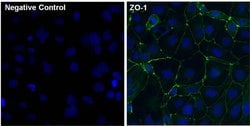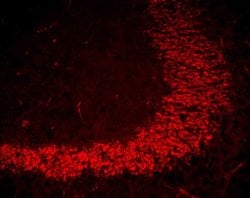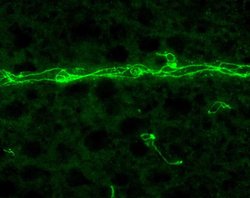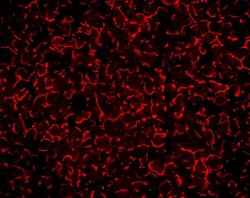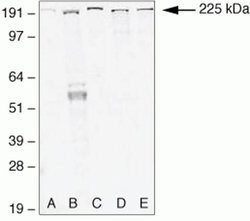Learn More
Invitrogen™ ZO-1 Polyclonal Antibody (ZMD.437)
Rabbit Polyclonal Antibody
Supplier: Invitrogen™ 402300

Description
This antibody reacts with the ZO-1 protein. Based on sequence homology, reactivity with ZO-2 or ZO-3 is not expected. 40-2300 has been successfully used in immunofluorescence and immunohistochemistry. However, for western blotting we recommend the use of monoclonal anti-ZO-1 antibody (Cat. No. 339100), or other polyclonal ZO-1 antibodies (Cat. Nos. 617300 or 402200). Reactivity has been confirmed with MDCK-II, Caco-2, Rat-1, and NRK52E cells by immunofluorescence. Reactivity has also been confirmed with frozen mouse liver, blood vessel (in heart), and mossy fiber terminal (in brain) tissues by immunohistochemistry and immunofluorescence, and with formalin-fixed, paraffin-embedded human pancreas, prostate, and small intestine tissues by immunohistochemistry. This antibody (or Cat. No. 187430) is recommended for immunohistochemical detection of ZO-1. For immunohistochemistry in formalin-fixed, paraffin-embedded tissues, tissue pretreatment with pepsin is required prior to staining. Some lots of this antibody have successfully been used in western blotting using human, dog and rat cell lysates. For immunofluorescence methanol fixation is preferred even though paraformaldehyde fixation will also work.
ZO-1 forms complexes with either ZO-2 or ZO-3. In addition, these proteins can also associate with claudin, occludin and F-actin, at tight junction stands, where they provide a linkage between the actin cytoskeleton and the tight junction. ZO-1 expression is significantly reduced in many breast cancer lines. ZO-2 and ZO-3 are ubiquitously expressed within epithelial tight junctions, and unlike ZO-1, which is also expressed at cell junctions of cardiac myocytes, ZO-2 is not expressed in nonepithelial tissue. ZO-1 is a protein located on a cytoplasmic membrane surface of intercellular tight junctions. ZO-1 may be involved in signal transduction at cell-cell junctions. Two transcript variants encoding distinct isoforms have been identified for the ZO-1 gene. Diseases associated with ZO-1 dysfunction include Celiac Disease and Congenital Nephrotic Syndrome.
Specifications
| ZO-1 | |
| Polyclonal | |
| 0.25 mg/mL | |
| PBS with 0.1% sodium azide; pH 7.4 | |
| O97758, P39447, Q07157 | |
| TJP1 | |
| Synthetic peptide derived from the N-terminal region of human, dog, mouse, and rat ZO-1. | |
| 100 μg | |
| Primary | |
| Human, Mouse, Rat, Canine | |
| Antibody | |
| IgG |
| Immunohistochemistry (Frozen), Immunohistochemistry (Paraffin), Western Blot, Immunocytochemistry | |
| ZMD.437 | |
| Unconjugated | |
| TJP1 | |
| DKFZp686M05161; I79_005485; MGC133289; OTTHUMP00000174520; Tight junction protein 1; tight junction protein 1 (zona occludens 1); tight junction protein ZO-1; Tjp1; zo1; ZO-1; ZO-1 MDCK; zona occludens 1; zona occludens protein 1; zonula occludens 1; zonula occludens 1 protein; zonula occludens protein 1 | |
| Rabbit | |
| Antigen affinity chromatography | |
| RUO | |
| 21872, 292994, 403752, 7082 | |
| -20°C | |
| Liquid |
The Fisher Scientific Encompass Program offers items which are not part of our distribution portfolio. These products typically do not have pictures or detailed descriptions. However, we are committed to improving your shopping experience. Please use the form below to provide feedback related to the content on this product.
